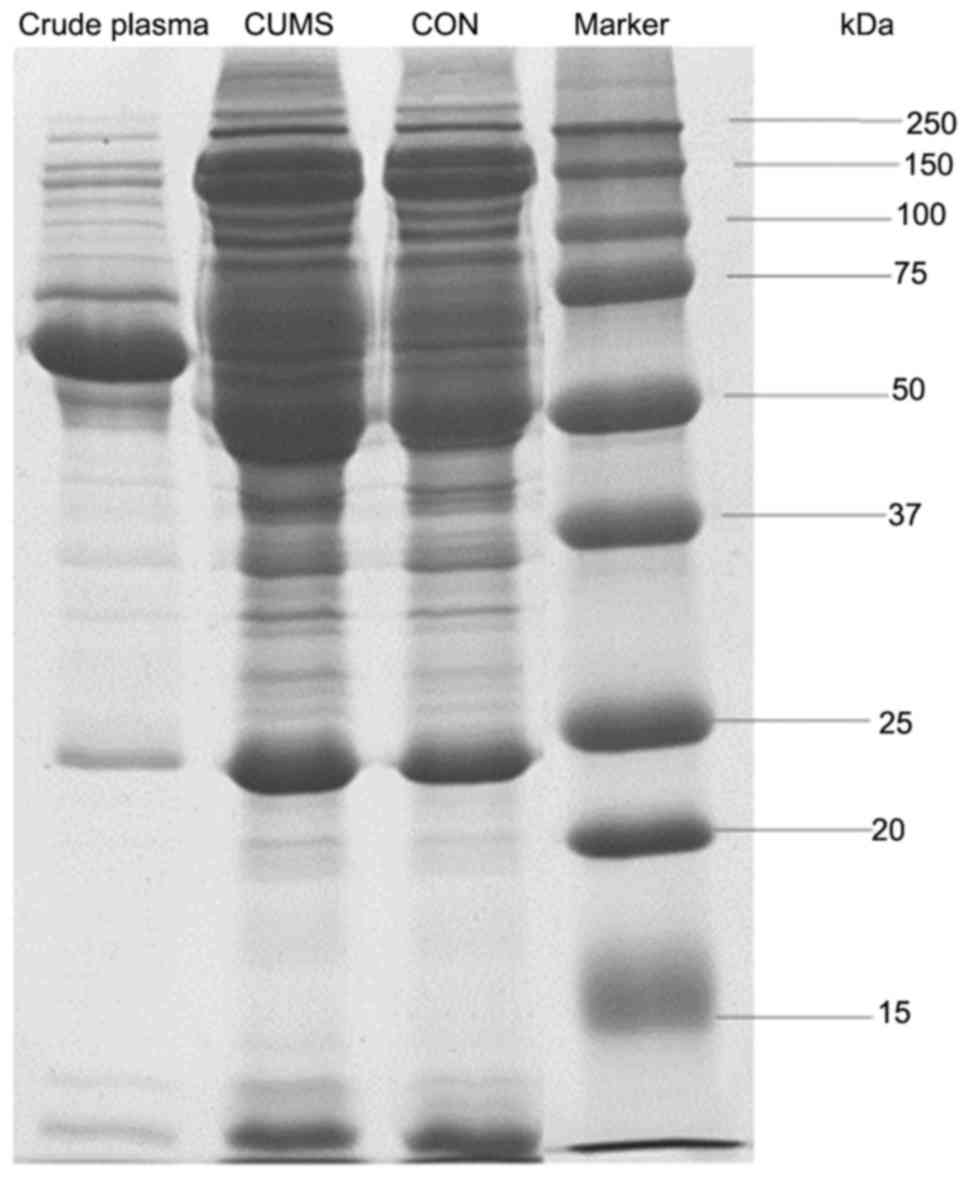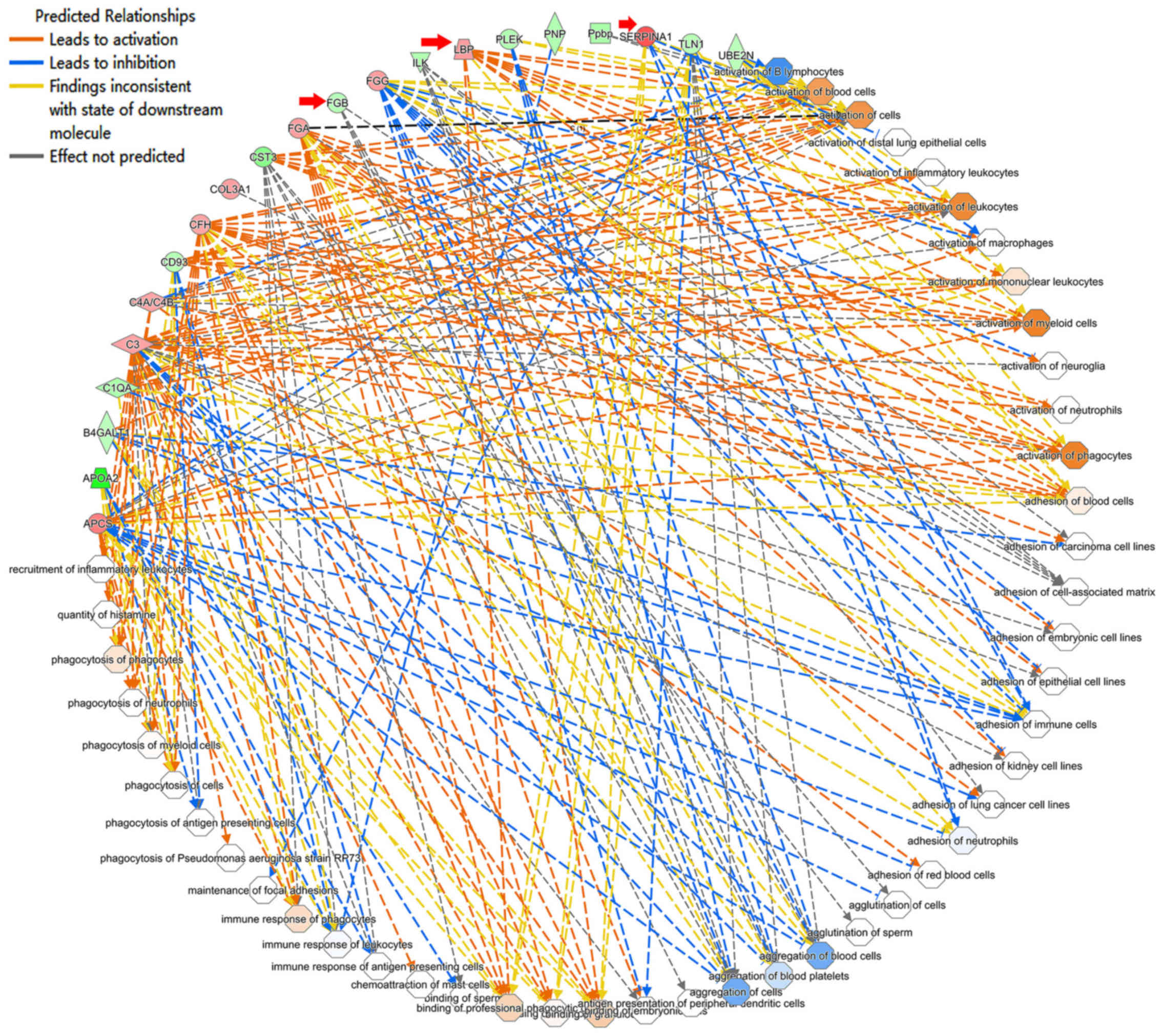|
1
|
Bakish D: New standard of depression
treatment: Remission and full recovery. J Clin Psychiatry. 62 Suppl
26:S5–S9. 2001.
|
|
2
|
Greenberg PE, Fournier AA, Sisitsky T,
Pike CT and Kessler RC: The economic burden of adults with major
depressive disorder in the United States (2005 and 2010). J Clin
Psychiatry. 76:155–162. 2015. View Article : Google Scholar : PubMed/NCBI
|
|
3
|
Bennett S and Thomas AJ: Depression and
dementia: Cause, consequence or coincidence? Maturitas. 79:184–190.
2014. View Article : Google Scholar : PubMed/NCBI
|
|
4
|
Belmaker RH and Agam G: Major depressive
disorder. N Engl J Med. 358:55–68. 2008. View Article : Google Scholar : PubMed/NCBI
|
|
5
|
Xu HB, Zhang RF, Luo D, Zhou Y, Wang Y,
Fang L, Li WJ, Mu J, Zhang L, Zhang Y and Xie P: Comparative
proteomic analysis of plasma from major depressive patients:
Identification of proteins associated with lipid metabolism and
immunoregulation. Int J Neuropsychopharmacol. 15:1413–1425. 2012.
View Article : Google Scholar : PubMed/NCBI
|
|
6
|
Yang Y, Chen J, Liu C, Fang L, Liu Z, Guo
J, Cheng K, Zhou C, Zhan Y, Melgiri ND, et al: The extrinsic
coagulation pathway: A biomarker for suicidal behavior in major
depressive disorder. Sci Rep. 6:328822016. View Article : Google Scholar : PubMed/NCBI
|
|
7
|
Song YR, Wu B, Yang YT, Chen J, Zhang LJ,
Zhang ZW, Shi HY, Huang CL, Pan JX and Xie P: Specific alterations
in plasma proteins during depressed, manic, and euthymic states of
bipolar disorder. Braz J Med Biol Res. 48:973–982. 2015. View Article : Google Scholar : PubMed/NCBI
|
|
8
|
Hinze-Selch D, Schuld A, Kraus T, Kühn M,
Uhr M, Haack M and Pollmächer T: Effects of antidepressants on
weight and on the plasma levels of leptin, TNF-α and soluble TNF
Receptors: A longitudinal study in patients treated with
amitriptyline or paroxetine. Neuropsychopharmacology. 23:13–19.
2000. View Article : Google Scholar : PubMed/NCBI
|
|
9
|
Wu Y, Tang J, Zhou C, Zhao L, Chen J, Zeng
L, Rao C, Shi H, Liao L, Liang Z, et al: Quantitative proteomics
analysis of the liver reveals immune regulation and lipid
metabolism dysregulation in a mouse model of depression. Behav
Brain Res. 311:330–339. 2016. View Article : Google Scholar : PubMed/NCBI
|
|
10
|
Rao C, Shi H, Zhou C, Zhu D, Zhao M, Wang
Z, Yang Y, Chen J, Liao L, Tang J, et al: Hypothalamic proteomic
analysis reveals dysregulation of glutamate balance and energy
metabolism in a mouse model of chronic mild stress-induced
depression. Neurochem Res. 41:2443–2456. 2016. View Article : Google Scholar : PubMed/NCBI
|
|
11
|
Cheng K, Li J, Yang D, Yang Y, Rao C,
Zhang S, Wang W, Guo H, Fang L, Zhu D, et al: 2D-gel based
proteomics unravels neurogenesis and energetic metabolism
dysfunction of the olfactory bulb in CUMS rat model. Behav Brain
Res. 313:302–309. 2016. View Article : Google Scholar : PubMed/NCBI
|
|
12
|
Yang Y, Yang D, Tang G, Zhou C, Cheng K,
Zhou J, Wu B, Peng Y, Liu C, Zhan Y, et al: Proteomics reveals
energy and glutathione metabolic dysregulation in the prefrontal
cortex of a rat model of depression. Neuroscience. 247:191–200.
2013. View Article : Google Scholar : PubMed/NCBI
|
|
13
|
Moussa E, Huang H, Ahras M, Lall A,
Thezenas ML, Fischer R, Kessler BM, Pain A, Billker O and
Casals-Pascual C: Proteomic profiling of the brain of mice with
experimental cerebral malaria. J Proteomics. Jun 5–2017.(Epub ahead
of print). View Article : Google Scholar : PubMed/NCBI
|
|
14
|
Niklasson F and Agren H: Brain energy
metabolism and blood-brain barrier permeability in depressive
patients: Analyses of creatine, creatinine, urate, and albumin in
CSF and blood. Biol Psychiatry. 19:1183–1206. 1984.PubMed/NCBI
|
|
15
|
Li J, Zhang SX, Wang W, Cheng K, Guo H,
Rao CL, Yang DY, He Y, Zou DZ, Han Y, et al: Potential
antidepressant and resilience mechanism revealed by metabolomic
study on peripheral blood mononuclear cells of stress resilient
rats. Behav Brain Res. 320:12–20. 2017. View Article : Google Scholar : PubMed/NCBI
|
|
16
|
Guest PC, Guest FL and Martins-de Souza D:
Making sense of blood-based proteomics and metabolomics in
psychiatric research. Int J Neuropsychopharmacol. Dec 30–2015.(Epub
ahead of print). View Article : Google Scholar : PubMed/NCBI
|
|
17
|
Wisniewski JR, Zougman A, Nagaraj N and
Mann M: Universal sample preparation method for proteome analysis.
Nat Methods. 6:359–362. 2009. View Article : Google Scholar : PubMed/NCBI
|
|
18
|
Gan CS, Chong PK, Pham TK and Wright PC:
Technical, experimental and biological variations in isobaric tags
for relative and absolute quantitation (iTRAQ). J Proteome Res.
6:821–827. 2007. View Article : Google Scholar : PubMed/NCBI
|
|
19
|
Brănescu C, Şerban D, Şavlovschi C,
Dascălu AM and Kraft A: Lipopolysaccharide binding protein
(L.B.P.)-an inflammatory marker of prognosis in the acute
appendicitis. J Med Life. 5:342–347. 2012.PubMed/NCBI
|
|
20
|
Berk M, Williams LJ, Jacka FN, O'Neil A,
Pasco JA, Moylan S, Allen NB, Stuart AL, Hayley AC, Byrne ML and
Maes M: So depression is an inflammatory disease, but where does
the inflammation come from? BMC Med. 11:2002013. View Article : Google Scholar : PubMed/NCBI
|
|
21
|
Ding PH and Jin LJ: The role of
lipopolysaccharide-binding protein in innate immunity: A revisit
and its relevance to oral/periodontal health. J Periodontal Res.
49:1–9. 2014. View Article : Google Scholar : PubMed/NCBI
|
|
22
|
Pahwa R, Devaraj S and Jialal I: The
effect of the accessory proteins, soluble CD14 and
lipopolysaccharide-binding protein on Toll-like receptor 4 activity
in human monocytes and adipocytes. Int J Obes (Lond). 40:907–911.
2016. View Article : Google Scholar : PubMed/NCBI
|
|
23
|
Liu J, Buisman-Pijlman F and Hutchinson
MR: Toll-like receptor 4: Innate immune regulator of neuroimmune
and neuroendocrine interactions in stress and major depressive
disorder. Front Neurosci. 8:3092014. View Article : Google Scholar : PubMed/NCBI
|
|
24
|
Pal GD, Shaikh M, Forsyth CB, Ouyang B,
Keshavarzian A and Shannon KM: Abnormal lipopolysaccharide binding
protein as marker of gastrointestinal inflammation in Parkinson
disease. Front Neurosci. 9:3062015. View Article : Google Scholar : PubMed/NCBI
|
|
25
|
Joyce PR, Hawes CR, Mulder RT, Sellman JD,
Wilson DA and Boswell DR: Elevated levels of acute phase plasma
proteins in major depression. Biol Psychiatry. 32:1035–1041. 1992.
View Article : Google Scholar : PubMed/NCBI
|
|
26
|
de Serres F and Blanco I: Role of alpha-1
antitrypsin in human health and disease. J Intern Med. 276:311–335.
2014. View Article : Google Scholar : PubMed/NCBI
|
|
27
|
Huang TL, Sung ML and Chen TY: 2D-DIGE
proteome analysis on the platelet proteins of patients with major
depression. Proteome Sci. 12:12014. View Article : Google Scholar : PubMed/NCBI
|
|
28
|
Cortelazzo A, Guerranti R, De Felice C,
Signorini C, Leoncini S, Pecorelli A, Landi C, Bini L, Montomoli B,
Sticozzi C, et al: A plasma proteomic approach in Rett syndrome:
Classical versus preserved speech variant. Mediators Inflamm.
2013:4386532013. View Article : Google Scholar : PubMed/NCBI
|
|
29
|
Edwards PA, Kennedy MA and Mak PA: LXRs;
oxysterol-activated nuclear receptors that regulate genes
controlling lipid homeostasis. Vascul Pharmacol. 38:249–256. 2002.
View Article : Google Scholar : PubMed/NCBI
|
|
30
|
Rizzo G, Renga B, Mencarelli A,
Pellicciari R and Fiorucci S: Role of FXR in regulating bile acid
homeostasis and relevance for human diseases. Curr Drug Targets
Immune Endocr Metabol Disord. 5:389–303. 2005. View Article : Google Scholar
|
|
31
|
Jia P, Kao CF, Kuo PH and Zhao Z: A
comprehensive network and pathway analysis of candidate genes in
major depressive disorder. BMC Syst Biol. 5 Suppl 3:S122011.
View Article : Google Scholar : PubMed/NCBI
|
|
32
|
Steri R, Achenbach J, Steinhilber D,
Schubert-Zsilavecz M and Proschak E: Investigation of imatinib and
other approved drugs as starting points for antidiabetic drug
discovery with FXR modulating activity. Biochem Pharmacol.
83:1674–1681. 2012. View Article : Google Scholar : PubMed/NCBI
|
|
33
|
Li GC, Zhang L, Yu M, Jia H, Tian T, Wang
J, Wang F and Zhou L: Identification of novel biomarker and
therapeutic target candidates for acute intracerebral hemorrhage by
quantitative plasma proteomics. Clin Proteomics. 14:142017.
View Article : Google Scholar : PubMed/NCBI
|
|
34
|
Ren L, Jiang ZQ, Fu Y, Leung WK and Jin L:
The interplay of lipopolysaccharide-binding protein and cytokines
in periodontal health and disease. J Clin Periodontol. 36:619–626.
2009. View Article : Google Scholar : PubMed/NCBI
|
|
35
|
Choe H, Sboner A, Beltran H, Nanus D and
Tagawa ST: PO-43 – Differential coagulation factor expression in
neuroendocrine prostate cancer (PC), metastatic castrate-resistant
PC, and localized prostatic adenocarcinoma. Thromb Res. 140 Suppl
1:S1922016. View Article : Google Scholar : PubMed/NCBI
|
|
36
|
Langley PG, Hughes RD, Rolando N and
Williams R: Increased elastase-alpha 1-antitrypsin complex in
fulminant hepatic failure: Relationship to bacterial infection and
activation of coagulation. Clin Chim Acta. 200:211–219. 1991.
View Article : Google Scholar : PubMed/NCBI
|
|
37
|
Howlett GJ and Moore KJ: Untangling the
role of amyloid in atherosclerosis. Curr Opin Lipidol. 17:541–547.
2006. View Article : Google Scholar : PubMed/NCBI
|
|
38
|
Subramaniyam D, Steele C, Köhnlein T,
Welte T, Grip O, Matalon S and Janciauskiene S: Effects of alpha
1-antitrypsin on endotoxin-induced lung inflammation in vivo.
Inflamm Res. 59:571–578. 2010. View Article : Google Scholar : PubMed/NCBI
|
|
39
|
Cheng W, Rolls ET, Qiu J, Liu W, Tang Y,
Huang CC, Wang X, Zhang J, Lin W, Zheng L, et al: Medial reward and
lateral non-reward orbitofrontal cortex circuits change in opposite
directions in depression. Brain. 139:3296–3309. 2016. View Article : Google Scholar : PubMed/NCBI
|

















